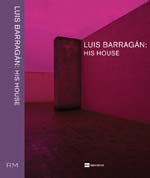
|

|
|
Home Site Search Contact Us Subscribe
|
|
|
Book Review: Laboratory Architecture for Observing Nature at Play Books on Luis Barragan's house and BNIM's Omega Center for Sustainable Living reveal how transparently daring designs teach Nature's processes. By Norman Weinstein March 16, 2012 Here are tales of two spellbindingly romantic works of architecture that I’m saddling with that most unromantic word, laboratory. No way around the word’s Latin root: labor. And generally we immediately associate “laboratory” with high-tech machinations, some site where priests of science do whatever they do isolated from scrutiny of scientifically illiterate commoners, yours truly included. As a teenager walking past the Richards Lab at the University of Pennsylvania, scanning various window panes covered with aluminum foil for necessary light and heat reduction, fantasies surfaced that the researchers within were engaged in unscientific but erotic or drug-induced activities between legitimate experiments. Seemed like a foreboding lab I needed to project recreation into, but then again, how many labs still are off-putting architecturally? But these two books worthy of close reading offer revealing re-definitions of laboratory architecture through examples over a half-century apart. And both volumes illuminate designs that are inviting laboratories for observing and learning from Nature’s processes in motion.
Luis Barragán: His House (Editorial RM, 2011) adds to the miniscule list of publications dedicated to Mexico’s most renowned architect, the winner of the 1980 Pritzker Prize, and a major influence on Tadao Ando and Steven Holl. In fact, Barragán’s Pritzker Prize acceptance speech is one of the four essays framing a vivid collection of photographs of the house and garden. Detailed house plans and a Barragán chronology conclude this precious volume. The photographs comprise the book’s core, as invaluable as the various commentaries are. As Barragán himself was prone to say, his house – now a UNESCO World Heritage site – was his laboratory.
Now what kind of laboratory can one discover in a modest three-story concrete house that, apart from scale, looks right at home with other modest residences in Mexico City’s Tacubaya suburb? Central to the Barragá́n house are an adjacent small private garden and an upper-level studio where the solitary designer worked. Walk into the house and you’re immediately confronted by plays of natural light reflected off surfaces of “non-harmonious colors,” fussy formal terminology in this instance for an interior palette found commonly in the tropics. Barragán’s shocking pink doors and walls only shock if you forget how profusely common pink dahlias punctuate Mexico’s landscapes. Whether Barragán had the intense pink of Mexican dahlias in mind when designing his residence – hardly improbable since they’re everywhere and carry the status of National Flower – is unknown. Another layer of dahlia association might be more curious. Dahlias were recognized in ancient Aztec and Toltec vernacular traditions as being usable as water pipes because of their long hollow stems. This point would not have been lost on Barragán who was formally trained solely as an engineer, never as an architect. Additionally, dahlias were used by these communities as both food and medicine, conjuring up the possibility of thinking of residential architecture as both healing space and kitchen/lab for nature’s harvest.
Blink after the initial shock of high-saturation pink and yellow interior surfaces, and begin to view the house, studio, and garden as laboratories for the sensual and analytic observation of nature at play. Barragán’s house demonstrates, through its overwhelmingly dramatic and energy-conscious use of natural light (supplemented only by a few table lamps), how an architect’s house simultaneously works as a laboratory for observing the play of light on massing, and as a contemplative spiritual sanctuary where large windows frame views of an enigmatically, somewhat labyrinthine, landscaped garden below. Somehow Barragán foresaw the 21st century in sustainable architecture from his 1948 house project vantage point as a meditative and educational demonstration of how design magnifies the presence of organized flows of Nature’s energies. A lifelong Catholic mystic, Barragán’s faith was encoded in his residential design since he believed that God spoke to him through playful circulatory flows of light, water, and wind in his bedroom as freely as in his studio. This book is next best to going to Mexico City to experience this hybrid house-laboratory for yourself.
Flow: The Making of the Omega Center for Sustainable Living (ORO Editions, 2011) chronicles the making of a combination water treatment plant and education center (acronym: OCSL) completed in 2008 on the grounds of The Omega Institute for Holistic Studies, a center for personal growth through classes in spirituality and the arts, in New York State’s mid-Hudson Valley. Designed by BNIM, a firm with a solid reputation in innovative sustainable design, this book is partially available on their website. Like the Barragán monograph, this book culls the work of diverse writers and photographers. And like Barragán’s house, OCSL is simultaneously practical and visionary, meditative and educational, rooted in transparently showcasing flows of natural energy as filtered through highly refined architectural experiences.
But while Barragán’s house-laboratory functioned for its sole resident as a lens on Nature, and as proof of Divine energy manifest in lawfully guided flows of light, wind, and water, OCSL is different in its purposes. BNIM designed OCSL to go beyond earning a LEED Platinum status and created one of the first buildings in the world to achieve “Living Building” Certification (follow link for pertinent technical details). To walk through OCSL is to learn how a cutting-edge wastewater treatment facility, relying on solar energy and waste-eating plants, works. OCSL’s design, like Barragán’s, is transparent to the layers of interrelated flows of Nature’s energies. But it is a far more advanced structure technologically than Barragan’s in that it actually does much more than offer utility and beauty and a “window” to Nature to its owner. It is a dazzlingly energy-efficient wastewater treatment facility addressing a current public need in a pastoral but increasingly dense area of the Hudson Valley. And harking back to Barragán’s spiritually-infused design, OCSL works as an educational facility open to the public where yoga is taught, where mixed-use design matches bodies of water becoming transformed with human bodies practicing healthy transformation. This book, like OCSL itself, blends material acumen with spiritual aspiration. It deserves a space next to Luis Barragán: His House. Both enhance the flow of sustainable thinking, and remind us that laboratories brilliantly designed are about so much more than labor. Romance lives there also.
Norman Weinstein writes about architecture and design for Architectural Record, and is the author of “Words That Build” – an exclusive 21-part series published by ArchNewsNow.com – that focuses on the overlooked foundations of architecture: oral and written communication. He consults with architects and engineers interested in communicating more profitably; his webinars are available from ExecSense. He can be reached at nweinstein@q.com.
More by Weinstein:
A Meditation on the Beauty of Zaha Hadid's Door Handle Hadid's design issues a challenge: define beauty by lyrically playing with illusion.
Why
"Greatest Hits" Lists by Architecture's Stars Should Be Mocked
Celebratory Meditations on SANAA Winning the Pritzker Prize
Op-Ed: Life After Ada: Reassessing the Utility of
Architectural Criticism
Book Review: Tracing
a Hidden Track from Adolf Loos as Modernist Architect to Jennifer Post as
Modernist Interior Designer
Two Books to
Accelerate the Translation of Ideas into Practical Forms
Book Review: How to
be a Useful Architectural Critic: Alexandra Lange's Perspicacious Primer Points
the Way
Michael Sorkin:
Architectural Critic as Scam Scanner and Urban(e) Design Sage
Best Architecture
Books of 2011
Book
Review: Pencils that Refuse to Die: Meditations about New Books on
Architectural Drawing
Book
Review: "One Million Acres & No Zoning": Lars Lerup's Outrageous
Encomium to Houston Instructs and Infuriates
Book
Review: Talkin' 'Bout (Not) My Generation: Uplifting Gen X Architects Showcase
Pragmatic Optimism
"Frank
Lloyd Wright's Guggenheim Museum": Bravura Example of an Architectural
Documentary - Wright's Guggenheim Done Right
Book
Review: Diving into Architecture from Every New Angle: Reading Guillevic's
"Geometries"
Book
Review: "Immaterial World: Transparency in Architecture": Marc
Kristal crystallizes increasingly complex notions of transparency with a light
touch.
Book
Review: "Visual Planning and the Picuresque" by Nikolaus Pevsner.
Edited by Mathew Aitchison
Book
Review: How New Urbanism's Case Triumphs Best Through "The Language of
Towns & Cities: A Visual Dictionary" by Dhiru A. Thadani
Best
Architecture Books of 2010
Book Review:
"Architecture and Beauty: Conversations with Architects about a Troubled
Relationship": Yael Reisner exuberantly interviews architects about beauty
Book
Review: Shedding Light on Concrete: Tadao Ando: Complete Works 1975-2010 by
Philip Jodidio
Book Review:
Sage Architectural Reflections from Architecture's "Athena": Denise
Scott Brown's "Having Words" distills a lifetime of theorizing and
practice into practical and succinct guidance for thriving through difficult
times
Book
Review: Keeping the Architectural Profession Professional: "Architecture
from the Outside In: Selected Essays by Robert Gutman" celebrates Gutman's
legacy as invaluable outsider
Book
Review: "Design through Dialogue: A Guide for Clients and
Architects," by Karen A. Franck and Teresa von Sommaruga Howard
Twilight Visions: Vintage Surrealist Photography Sheds
New Light on Architecture
Best
Architecture Books of 2009
Book Review: "Gunnar Birkerts: Metaphoric Modernist" by Sven Birkerts and Martin Schwartz A major architect in the history of Modernism finally receives recognition – and sundry asides about why Modernism never exited.
Book Review: "Urban
Design for an Urban Century: Placemaking for People," by Lance Jay Brown,
David Dixon, and Oliver Gillham
Book Review:
"Everything Must Move: 15 Years at Rice School of Architecture
1994-2009"
Book Review: A Subversive Book Every Architect Needs:
"Architect's Essentials of Negotiation" by Ava J. Abramowitz
Book Review: A Perspective from One Elevation: "Conversations With Frank Gehry" by Barbara Isenberg Gehry's conversations offer portraits of an astute listener as well as talker, an architect as aware of his flaws and limitations as of his virtues.
Best Architecture Books of 2008
Book Review: You've Got to Draw the Line Somewhere A review of Drafting Culture: a Social History of Architectural Graphic Standards by George Barnett Johnston
Book Review: "NeoHooDoo: Art for a Forgotten Faith," edited by Franklin Sirmans Sharpen your pencils - and get ready to do a NeoHooDoo shimmy.
|
(click on pictures to enlarge) 

|
© 2012 ArchNewsNow.com